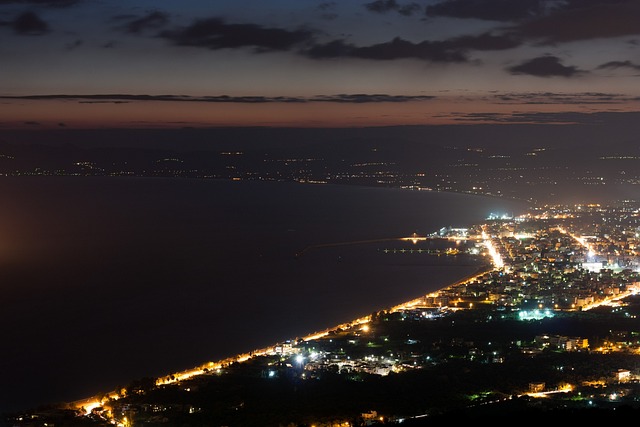Plateia Basileos Georgiou - The Historic Heart of Kalamata, Messinia, Greece
Plateia Basileos Georgiou, also known as King George Square, is a historic square located in the heart of Kalamata, Messinia, Greece. The square has played a significant role in the city's history, cultural and political life and has been witness to many important events and milestones over the years.
The square was originally named after King George I of Greece, who was the first monarch of modern Greece, ruling the country from 1863 to 1913. In the early 19th century, Kalamata was a small town with a population of around 5,000 people. In the mid-19th century, as the city grew and developed, it became an important center of trade and commerce, and the need for a public space for social and political gatherings became apparent. The square was designed by the German architect Ernst Ziller, who was known for his work in Athens and other Greek cities.
The construction of the square began in the late 19th century and was completed in the early 20th century. The square was built in a neoclassical style, which was popular in Greece at the time, and it featured a large central fountain, surrounded by palm trees and benches.
In the early 20th century, Plateia Basileos Georgiou became a popular destination for social gatherings, political rallies, and cultural events. It was the site of many important speeches and demonstrations, and it played a significant role in the city's political life.
During World War II, Plateia Basileos Georgiou played a crucial role in the resistance movement against the Axis powers. The square was the site of many clandestine meetings and rallies, and it served as a hub for the distribution of underground newspapers and pamphlets. The resistance movement in Kalamata was one of the most active in Greece, and Plateia Basileos Georgiou was at the heart of its activities.
After the war, the square became a symbol of Kalamata's resilience and endurance. It was restored to its former glory and underwent significant renovations. It continued to serve as a hub for social and cultural activities and became a popular destination for tourists and locals alike. In the 1960s and 1970s, the square was the site of many important protests and demonstrations, including rallies against the military dictatorship that ruled Greece at the time.
In the decades that followed, Plateia Basileos Georgiou became a cultural and social center of the city. It was the site of many cultural events, including concerts, theater productions, and art exhibitions. The square was also home to many cafes, restaurants, and shops, making it a popular gathering place for locals and visitors alike.
In 1986, Plateia Basileos Georgiou underwent another major renovation, which included the installation of a fountain and the planting of trees and flowers. The square was also expanded to include a pedestrianized area, which made it more accessible and enjoyable for visitors.
Today, Plateia Basileos Georgiou is a vibrant and bustling square that retains its historic charm while offering modern amenities and attractions. It has been recently renovated with new sidewalks, lighting, and benches. It is surrounded by beautiful neoclassical buildings and is home to many cafes, restaurants, and shops. The square is also a popular destination for cultural events, with concerts, festivals, art exhibitions, and other performances taking place throughout the year.
The square was originally named after King George I of Greece, who was the first monarch of modern Greece, ruling the country from 1863 to 1913. In the early 19th century, Kalamata was a small town with a population of around 5,000 people. In the mid-19th century, as the city grew and developed, it became an important center of trade and commerce, and the need for a public space for social and political gatherings became apparent. The square was designed by the German architect Ernst Ziller, who was known for his work in Athens and other Greek cities.
The construction of the square began in the late 19th century and was completed in the early 20th century. The square was built in a neoclassical style, which was popular in Greece at the time, and it featured a large central fountain, surrounded by palm trees and benches.
In the early 20th century, Plateia Basileos Georgiou became a popular destination for social gatherings, political rallies, and cultural events. It was the site of many important speeches and demonstrations, and it played a significant role in the city's political life.
During World War II, Plateia Basileos Georgiou played a crucial role in the resistance movement against the Axis powers. The square was the site of many clandestine meetings and rallies, and it served as a hub for the distribution of underground newspapers and pamphlets. The resistance movement in Kalamata was one of the most active in Greece, and Plateia Basileos Georgiou was at the heart of its activities.
After the war, the square became a symbol of Kalamata's resilience and endurance. It was restored to its former glory and underwent significant renovations. It continued to serve as a hub for social and cultural activities and became a popular destination for tourists and locals alike. In the 1960s and 1970s, the square was the site of many important protests and demonstrations, including rallies against the military dictatorship that ruled Greece at the time.
In the decades that followed, Plateia Basileos Georgiou became a cultural and social center of the city. It was the site of many cultural events, including concerts, theater productions, and art exhibitions. The square was also home to many cafes, restaurants, and shops, making it a popular gathering place for locals and visitors alike.
In 1986, Plateia Basileos Georgiou underwent another major renovation, which included the installation of a fountain and the planting of trees and flowers. The square was also expanded to include a pedestrianized area, which made it more accessible and enjoyable for visitors.
Today, Plateia Basileos Georgiou is a vibrant and bustling square that retains its historic charm while offering modern amenities and attractions. It has been recently renovated with new sidewalks, lighting, and benches. It is surrounded by beautiful neoclassical buildings and is home to many cafes, restaurants, and shops. The square is also a popular destination for cultural events, with concerts, festivals, art exhibitions, and other performances taking place throughout the year.

